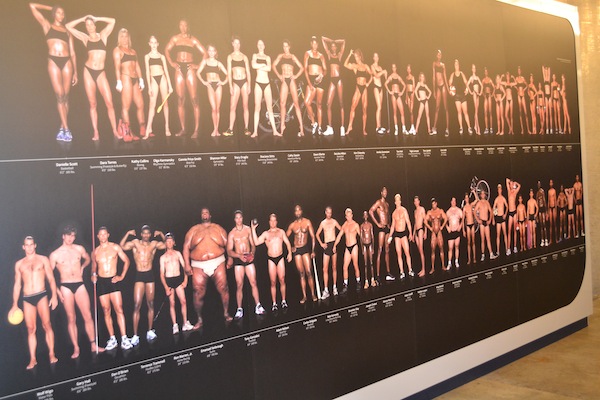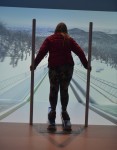Try your hand at ski jumping in one of ROX’s five simulators. (photo from ROX)
There’s no question the 2010 Winter Olympics in Vancouver changed the region considerably, but some of those changes are as recent as November 2015. That’s when the Richmond Olympic Experience, or ROX, opened at the Richmond Olympic Oval, the massive structure built on the banks of the Fraser River to accommodate the Olympics’ speed-skating competitions.
A $10 million museum, ROX is all about hands-on experience and is filled with interactive exhibits and activities that engage visitors. Take the five sport simulators, for example, three of them designed and manufactured specifically for ROX. On the ski-jump simulator, you experience the thrill of ski jumping on one of Whistler’s world-class runs, while on the bobsleigh you feel the rush of speed on the same track traveled by Canadian Olympic bobsledder Chris Spring. There’s a race-car simulator, a kayak and a sit-ski simulator, too. While the simulators are the most exciting of the interactive exhibits (and the highest in demand), there are many others. Visitors are encouraged to learn how high and how far they can jump, to measure their hand-eye and foot-eye reaction times, to score goals in soccer and hockey and to compare their results to those of Olympic athletes.
There are also lots of interesting artifacts, including a display of Olympic torches that date back to 1936, when the torch relay was introduced to the Games by Adolf Hitler’s Nazi party. One case displays sports equipment including tennis rackets, showing how they have evolved over the years. Another showcases Olympic medals, which have also changed considerably in size and design over time. For those who want to spend time researching the participation of a specific country in the Olympic Games, or the performance of one or more athletes, ROX has a data lounge where a wealth of information is digitally archived and easily accessible.
There are many images at ROX. One of my personal favorites is a massive photograph of athletes who have competed, all wearing black bikinis or swimsuits. Since they’re scantily clad you can get a sense of the many different body types and how a specific sport has shaped individual bodies. The photographic collage delivers a powerful message about the beauty of the human body and the many reflections of that beauty, big and small.

While most of the displays are not specific to the 2010 Winter Olympics in Vancouver but cover the Games in general, there is one wall that pays tribute to the 2010 Games with statistics on how many medals Canada won that year (26), how many viewers watched on TV (1.8 billion!) and how many media representatives were present (a mere 10,000). A large screen in the vicinity replays the most memorable moments from the Games and another encourages visitors to try their hand at being a TV announcer.
One wall pays a noticeably teensy tribute to tragic Olympic events. It’s here that the 1972 massacre of Israeli Olympic athletes in Munich is mentioned in two short lines.
Of the plethora of museums about the Olympics worldwide, only 21 are accredited members of the IOC Olympic Museums Network. ROX is the only member of this network in North America and that membership allowed the City of Richmond to expand its budget from the humble $575,000 initially allocated for the museum to $10 million, by opening the door to a robust sponsorship drive. It also enabled loans of Olympic resources like the torches. Ted Townsend, spokesperson for the City of Richmond, said the most priceless exhibit at ROX is that of the medals and torches.
While you’re at ROX take a peek at the Olympic Oval. After the dismantling of the speed-skating rinks, it now includes two hockey rinks, facilities for pilates and yoga, courts for badminton, baseball, basketball, soccer, table tennis, tennis and volleyball, a wall for climbing, and areas for golf, gymnastics and rowing. And don’t forget to look up at the wood panels of the Oval’s roof. Created from pine beetle-damaged wood, it contains the signatures of 8,000 Richmond residents who inscribed their names in the early construction stages.
For more information, visit therox.ca or call 778-296-1400.
Lauren Kramer, an award-winning writer and editor, lives in Richmond. To read her work online, visit laurenkramer.net.

